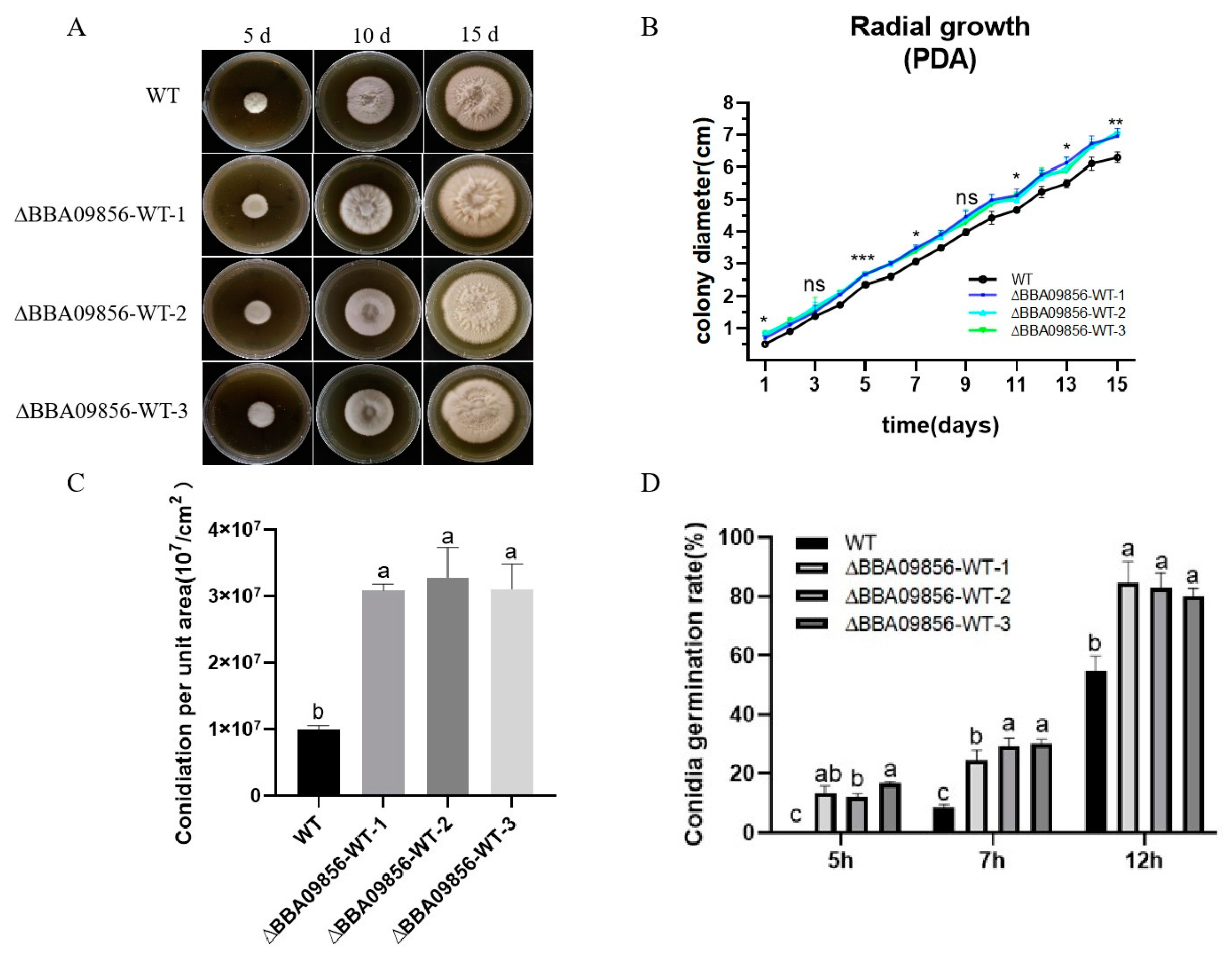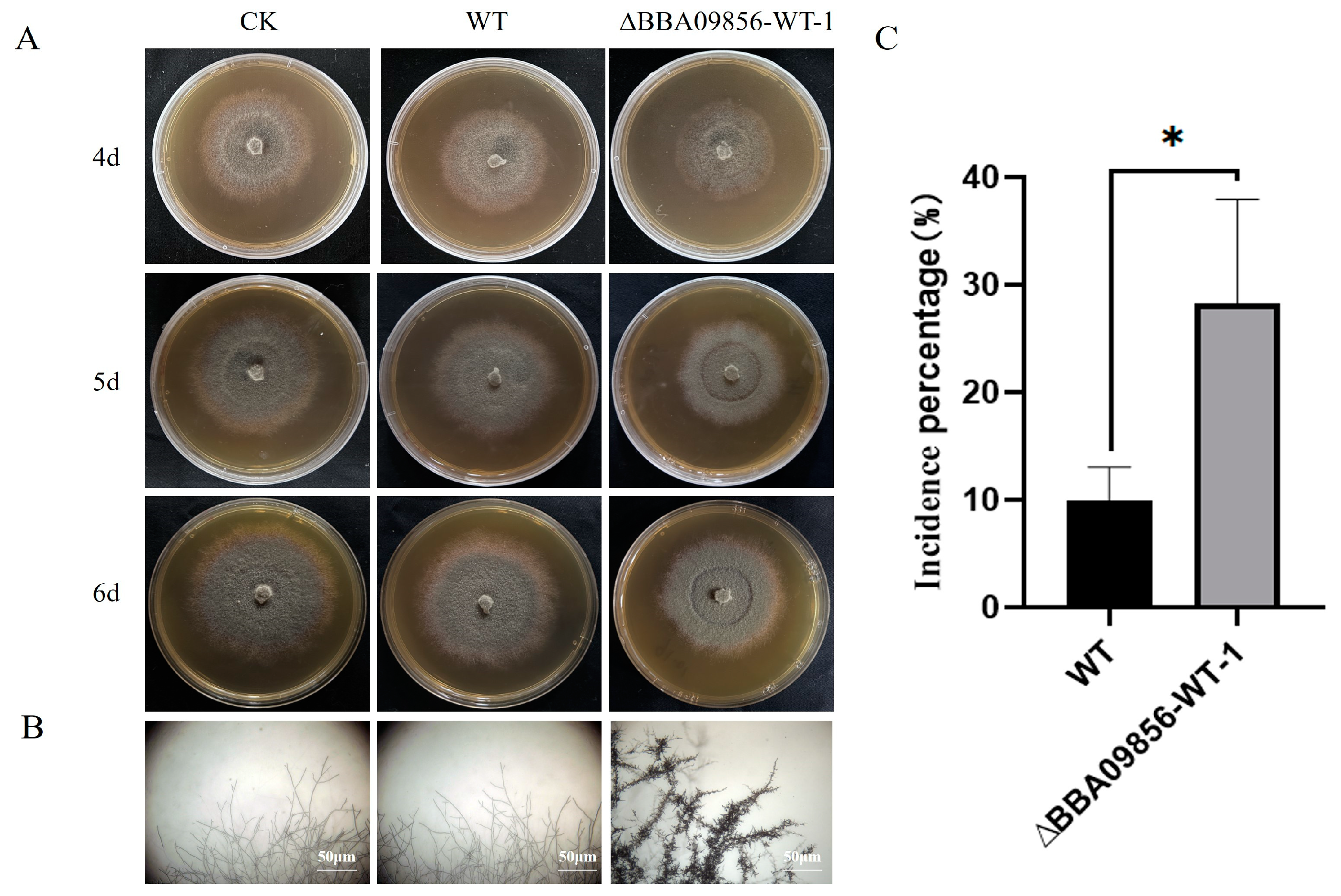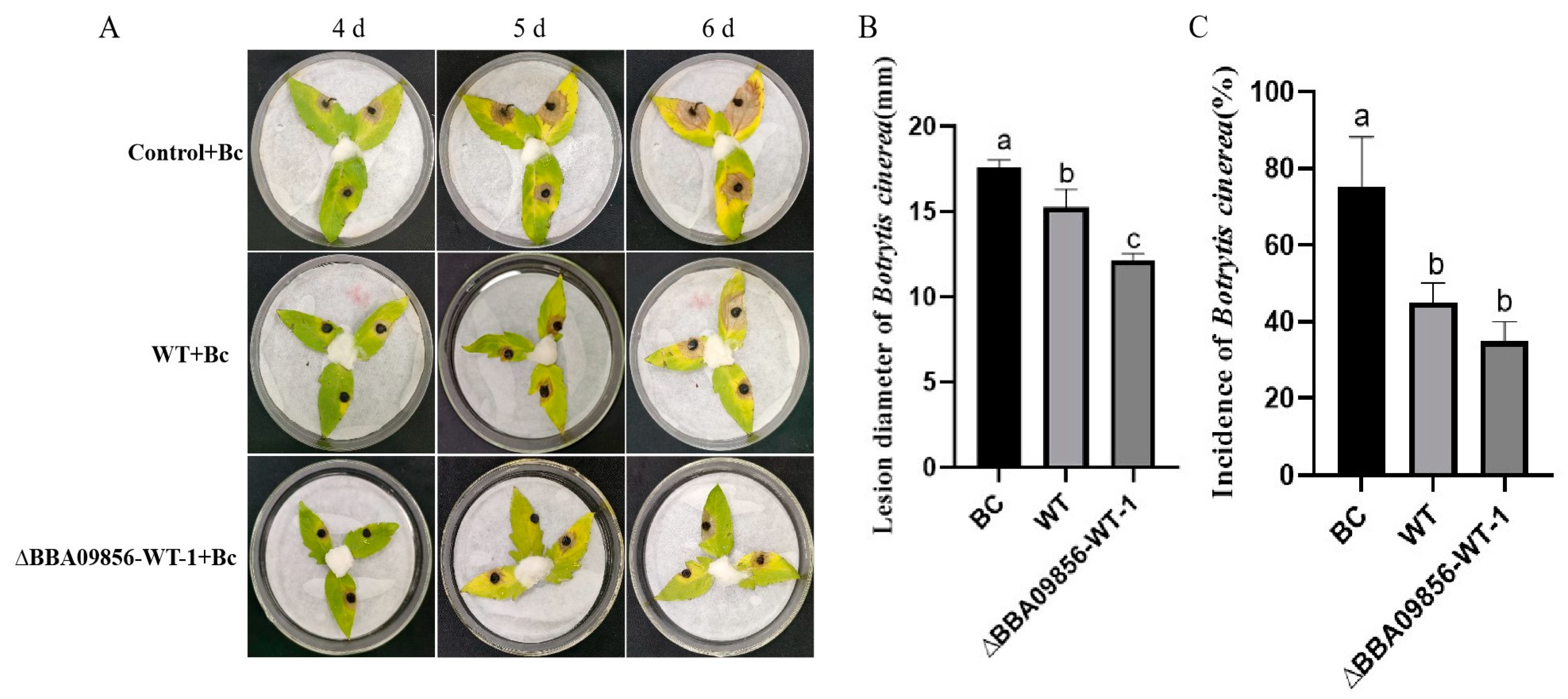The PKS–NRPS Gene BBA_09856 Deletion Mutant of Beauveria bassiana Enhanced Its Virulence Against Ostrinia furnacalis Larvae and Strengthened the Host Plant’s Resistance to Botrytis cinerea as an Endotype
Abstract
:1. Introduction
2. Materials and Methods
2.1. Sources of Insect and Fungal Isolates
2.2. Extraction of Genomic DNA from B. bassiana
2.3. Targeted Gene Deletion
2.4. Plant Material Origin and Preparation
2.5. Preparation of B. bassiana Culture and Conidial Suspension
2.6. Plant Inoculation with B. bassiana and B. cinerea
2.7. The Biological Characteristics of the Mutant Strain ∆BBA09856-WT
2.8. Assessing the Virulence of the Tested B. bassiana Strains Against O. furnacalis
2.9. Testing the Antagonistic Activity of ∆BBA09856-WT Against B. cinerea In Vitro
2.10. Assessment of Gray Mold Resistance Induced by the Tested Strains of B. bassiana in Planta
2.11. Statistical Analysis
3. Results
3.1. Construction of the Vector
3.2. Screening of Transformants
3.3. The Biological Characteristics of the Mutant ∆BBA09856-WT
3.4. Virulence of the Mutant Strain ∆BBA09856-WT Toward O. furnacalis
3.5. The Antagonistic Activity of the ∆BBA09856-WT Mutant Against B. cinerea
3.6. Secondary Metabolites from B. bassiana Inhibited the Growth of B. cinerea
3.7. Impact on the In Vitro Leaf Defense Effectiveness Against B. cinerea
4. Discussion
5. Conclusions
Supplementary Materials
Author Contributions
Funding
Institutional Review Board Statement
Informed Consent Statement
Data Availability Statement
Conflicts of Interest
References
- Altimira, F.; Arias-Aravena, M.; Jian, L.; Real, N.; Correa, P.; González, C.; Godoy, S.; Castro, J.F.; Zamora, O.; Vergara, C.; et al. Genomic and Experimental Analysis of the Insecticidal Factors Secreted by the Entomopathogenic Fungus Beauveria pseudobassiana RGM 2184. J. Fungi 2022, 8, 253. [Google Scholar] [CrossRef]
- Paschapur, A.; Subbanna, A.R.N.S.; Singh, A.K.; Jeevan, B.; Mishra, K.K. Unraveling the Importance of Metabolites from Entomopathogenic Fungi in Insect Pest Management. In Microbes for Sustainable lnsect Pest Management. Sustainability in Plant and Crop Protection; Springer: Cham, Switzerland, 2021. [Google Scholar] [CrossRef]
- Meng, X.; Liao, Z.; Liu, T.; Hussain, K.; Chen, J.; Fang, Q.; Wang, J. Vital Roles of Pks11, a Highly Reducing Polyketide Synthase, in Fungal Conidiation, Antioxidant Activity, Conidial Cell Wall Integrity, and UV Tolerance of Beauveria bassiana. J. Invertebr. Pathol. 2021, 181, 107588. [Google Scholar] [CrossRef]
- Branine, M.; Bazzicalupo, A.; Branco, S. Biology and Applications of Endophytic Insect-Pathogenic Fungi. PLoS Pathog. 2019, 15, e1007831. [Google Scholar] [CrossRef] [PubMed]
- Mannino, M.C.; Huarte-Bonnet, C.; Davyt-Colo, B.; Pedrini, N. Is the Insect Cuticle the Only Entry Gate for Fungal Infection? Insights into Alternative Modes of Action of Entomopathogenic Fungi. J. Fungi 2019, 5, 33. [Google Scholar] [CrossRef] [PubMed]
- Mantzoukas, S.; Eliopoulos, P.A. Endophytic Entomopathogenic Fungi: A Valuable Biological Control Tool against Plant Pests. Appl. Sci. 2020, 10, 360. [Google Scholar] [CrossRef]
- Wang, J.; Ma, Y.; Liu, Y.; Tong, S.; Zhu, S.; Jin, D.; Pei, Y.; Fan, Y. A Polyketide Synthase, BbpksP, Contributes to Conidial Cell Wall Structure and UV Tolerance in Beauveria bassiana. J. Invertebr. Pathol. 2020, 169, 107280. [Google Scholar] [CrossRef]
- Ortiz-Urquiza, A.; Keyhani, N.O. Molecular Genetics of Beauveria bassiana Infection of Insects. Adv. Genet. 2016, 94, 165–249. [Google Scholar] [CrossRef]
- Fernandes, É.K.K.; Rangel, D.E.N.; Braga, G.U.L.; Roberts, D.W. Tolerance of Entomopathogenic Fungi to Ultraviolet Radiation: A Review on Screening of Strains and Their Formulation. Curr. Genet. 2015, 61, 427–440. [Google Scholar] [CrossRef]
- Wang, H.; Peng, H.; Li, W.; Cheng, P.; Gong, M. The Toxins of Beauveria bassiana and the Strategies to Improve Their Virulence to Insects. Front. Microbiol. 2021, 12, 705343. [Google Scholar] [CrossRef]
- Wang, J.; Liu, J.; Hu, Y.; Ying, S.-H.; Feng, M.-G. Cytokinesis-Required Cdc14 Is a Signaling Hub of Asexual Development and Multi-Stress Tolerance in Beauveria bassiana. Sci. Rep. 2013, 3, 3086. [Google Scholar] [CrossRef]
- Butt, T.M.; Coates, C.J.; Dubovskiy, I.M.; Ratcliffe, N.A. Entomopathogenic Fungi: New Insights into Host-Pathogen Interactions. Adv. Genet. 2016, 94, 307–364. [Google Scholar] [CrossRef] [PubMed]
- Sain, S.K.; Monga, D.; Hiremani, N.S.; Nagrale, D.T.; Kranthi, S.; Kumar, R.; Kranthi, K.R.; Tuteja, O.P.; Waghmare, V.N. Evaluation of Bioefficacy Potential of Entomopathogenic Fungi against the Whitefly (Bemisia tabaci Genn.) on Cotton under Polyhouse and Field Conditions. J. Invertebr. Pathol. 2021, 183, 107618. [Google Scholar] [CrossRef] [PubMed]
- Wilcken, C.F.; Dal Pogetto, M.H.F.d.A.; Lima, A.C.V.; Soliman, E.P.; Fernandes, B.V.; da Silva, I.M.; Zanuncio, A.J.V.; Barbosa, L.R.; Zanuncio, J.C. Chemical vs Entomopathogenic Control of Thaumastocoris peregrinus (Hemiptera: Thaumastocoridae) via Aerial Application in Eucalyptus Plantations. Sci. Rep. 2019, 9, 9416. [Google Scholar] [CrossRef] [PubMed]
- Altimira, F.; De La Barra, N.; Godoy, P.; Roa, J.; Godoy, S.; Vitta, N.; Tapia, E. Lobesia Botrana: A Biological Control Approach with a Biopesticide Based on Entomopathogenic Fungi in the Winter Season in Chile. Insects 2021, 13, 8. [Google Scholar] [CrossRef]
- Zhang, L.; Yue, Q.; Wang, C.; Xu, Y.; Molnár, I. Secondary Metabolites from Hypocrealean Entomopathogenic Fungi: Genomics as a Tool to Elucidate the Encoded Parvome. Nat. Prod. Rep. 2020, 37, 1164–1180. [Google Scholar] [CrossRef]
- Marahiel, M.A.; Essen, L.-O. Chapter 13. Nonribosomal Peptide Synthetases Mechanistic and Structural Aspects of Essential Domains. Methods Enzymol. 2009, 458, 337–351. [Google Scholar] [CrossRef]
- Liu, H.; Xie, L.; Wang, J.; Guo, Q.; Yang, S.; Liang, P.; Wang, C.; Lin, M.; Xu, Y.; Zhang, L. The Stress-Responsive and Host-Oriented Role of Nonribosomal Peptide Synthetases in an Entomopathogenic Fungus, Beauveria bassiana. J. Microbiol. Biotechnol. 2017, 27, 439–449. [Google Scholar] [CrossRef]
- Feng, P.; Shang, Y.; Cen, K.; Wang, C. Fungal Biosynthesis of the Bibenzoquinone Oosporein to Evade Insect Immunity. Proc. Natl. Acad. Sci. USA 2015, 112, 11365–11370. [Google Scholar] [CrossRef]
- Srisuksam, C.; Punya, J.; Wattanachaisaereekul, S.; Toopaang, W.; Cheevadhanarak, S.; Tanticharoen, M.; Amnuaykanjanasin, A. The Reducing Clade IIb Polyketide Synthase PKS14 Acts as a Virulence Determinant of the Entomopathogenic Fungus Beauveria bassiana. FEMS Microbiol. Lett. 2018, 365, fny131. [Google Scholar] [CrossRef]
- Toopaang, W.; Phonghanpot, S.; Punya, J.; Panyasiri, C.; Klamchao, K.; Wasuwan, R.; Srisuksam, C.; Sangsrakru, D.; Sonthirod, C.; Tangphatsornruang, S.; et al. Targeted Disruption of the Polyketide Synthase Gene pks15 Affects Virulence against Insects and Phagocytic Survival in the Fungus Beauveria bassiana. Fungal Biol. 2017, 121, 664–675. [Google Scholar] [CrossRef]
- Udompaisarn, S.; Toopaang, W.; Sae-Ueng, U.; Srisuksam, C.; Wichienchote, N.; Wasuwan, R.; Nahar, N.A.S.; Tanticharoen, M.; Amnuaykanjanasin, A. The Polyketide Synthase PKS15 Has a Crucial Role in Cell Wall Formation in Beauveria bassiana. Sci. Rep. 2020, 10, 12630. [Google Scholar] [CrossRef]
- Sui, L.; Lu, Y.; Zhu, H.; Wan, T.; Li, Q.; Zhang, Z. Endophytic Blastospores of Beauveria bassiana Provide High Resistance against Plant Disease Caused by Botrytis cinerea. Fungal Biol. 2022, 126, 528–533. [Google Scholar] [CrossRef] [PubMed]
- Tefera, T.; Vidal, S. Effect of Inoculation Method and Plant Growth Medium on Endophytic Colonization of Sorghum by the Entomopathogenic Fungus Beauveria bassiana. Biocontrol 2009, 54, 663–669. [Google Scholar] [CrossRef]
- Parsa, S.; Ortiz, V.; Vega, F.E. Establishing Fungal Entomopathogens as Endophytes: Towards Endophytic Biological Control. J. Vis. Exp. 2013, 74, 50360. [Google Scholar] [CrossRef]
- Bing, L.A.; Lewis, L.C. Suppression of Ostrinia nubilalis (Hübner) (Lepidoptera: Pyralidae) by Endophytic Beauveria bassiana (Balsamo) Vuillemin. Environ. Entomol. 1991, 20, 1207–1211. [Google Scholar] [CrossRef]
- Cherry, A.J.; Banito, A.; Djegui, D.; Lomer, C. Suppression of the Stem-Borer Sesamia calamistis (Lepidoptera; Noctuidae) in Maize Following Seed Dressing, Topical Application and Stem Injection with African Isolates of Beauveria bassiana. Pans Pest. Artic. News Summ. 2004, 50, 67–73. [Google Scholar] [CrossRef]
- Pinnamaneni, R.; Kalidas, P.; Sambasiva Rao, K.R.S. Studies on the Cloning and Expression of Bbchit1 Gene of Beauveria bassiana NCIM 1216. Indian J. Microbiol. 2011, 51, 396–402. [Google Scholar] [CrossRef]
- Cen, K.; Li, B.; Lu, Y.; Zhang, S.; Wang, C. Divergent LysM Effectors Contribute to the Virulence of Beauveria bassiana by Evasion of Insect Immune Defenses. PLoS Pathog. 2017, 13, e1006604. [Google Scholar] [CrossRef]
- Fang, W.; Zhang, Y.; Yang, X.; Zheng, X.; Duan, H.; Li, Y.; Pei, Y. Agrobacterium Tumefaciens-Mediated Transformation of Beauveria bassiana Using an Herbicide Resistance Gene as a Selection Marker. J. Invertebr. Pathol. 2004, 85, 18–24. [Google Scholar] [CrossRef]
- Sui, L.; Lu, Y.; Zhou, L.; Li, N.; Li, Q.; Zhang, Z. Endophytic Beauveria bassiana Promotes Plant Biomass Growth and Suppresses Pathogen Damage by Directional Recruitment. Front. Microbiol. 2023, 14, 1227269. [Google Scholar] [CrossRef]
- Kang, Q.; Ning, S.; Sui, L.; Lu, Y.; Zhao, Y.; Shi, W.; Li, Q.; Zhang, Z. Transcriptomic Analysis of Entomopathogenic Fungus Beauveria bassiana Infected by a Hypervirulent Polymycovirus BbPmV-4. Fungal Biol. 2023, 127, 958–967. [Google Scholar] [CrossRef] [PubMed]
- Sui, L.; Lu, Y.; Xu, M.; Liu, J.; Zhao, Y.; Li, Q.; Zhang, Z. Insect Hypovirulence-Associated Mycovirus Confers Entomopathogenic Fungi with Enhanced Resistance against Phytopathogens. Virulence 2024, 15, 2401978. [Google Scholar] [CrossRef] [PubMed]
- Li, T.; Zhou, J.; Li, J. Combined effects of temperature and humidity on the interaction between tomato and Botrytis cinerea revealed by integration of histological characteristics and transcriptome sequencing. Hortic. Res. 2023, 10, 53–64. [Google Scholar] [CrossRef] [PubMed]
- Li, S.; Hui, Z.; Wenjing, X.; Qinfeng, G.; Ling, W.; Zhengkun, Z.; Qiyun, L.; Deli, W. Elevated Air Temperature Shifts the Interactions between Plants and Endophytic Fungal Entomopathogens in an Agroecosystem. Fungal Ecol. 2020, 47, 100940. [Google Scholar] [CrossRef]
- Yun, C.-S.; Motoyama, T.; Osada, H. Biosynthesis of the Mycotoxin Tenuazonic Acid by a Fungal NRPS-PKS Hybrid Enzyme. Nat. Commun. 2015, 6, 8758. [Google Scholar] [CrossRef]
- Fisch, K.M. Biosynthesis of Natural Products by Microbial Iterative Hybrid PKS–NRPS. RSC Adv. 2013, 3, 18228. [Google Scholar] [CrossRef]
- Boettger, D.; Hertweck, C. Molecular Diversity Sculpted by Fungal PKS-NRPS Hybrids. ChemBioChem 2013, 14, 28–42. [Google Scholar] [CrossRef]
- Böhnert, H.U.; Fudal, I.; Dioh, W.; Tharreau, D.; Notteghem, J.-L.; Lebrun, M.-H. A Putative Polyketide Synthase/Peptide Synthetase from Magnaporthe grisea Signals Pathogen Attack to Resistant Rice. Plant Cell 2004, 16, 2499–2513. [Google Scholar] [CrossRef]
- Song, Z.; Cox, R.J.; Lazarus, C.M.; Simpson TJ, T.J. Fusarin C Biosynthesis in Fusarium moniliforme and Fusarium venenatum. ChemBioChem 2004, 5, 1196–1203. [Google Scholar] [CrossRef]
- Eley, K.L.; Halo, L.M.; Song, Z.; Powles, H.; Cox, R.J.; Bailey, A.M.; Lazarus, C.M.; Simpson, T.J. Biosynthesis of the 2-Pyridone Tenellin in the Insect Pathogenic Fungus Beauveria bassiana. ChemBioChem 2007, 8, 289–297. [Google Scholar] [CrossRef]
- Hertweck, C.; Luzhetskyy, A.; Rebets, Y.; Bechthold, A. Type II Polyketide Synthases: Gaining a Deeper Insight into Enzymatic Teamwork. Nat. Prod. Rep. 2007, 24, 162–190. [Google Scholar] [CrossRef] [PubMed]
- Pedrini, N. The Entomopathogenic Fungus Beauveria bassiana Shows Its Toxic Side within Insects: Expression of Genes Encoding Secondary Metabolites during Pathogenesis. J. Fungi 2022, 8, 488. [Google Scholar] [CrossRef] [PubMed]
- Patel, P.S.; Huang, S.; Fisher, S.; Pirnik, D.; Aklonis, C.; Dean, L.; Meyers, E.; Fernandes, P.; Mayerl, F. Bacillaene, a Novel Inhibitor of Procaryotic Protein Synthesis Produced by Bacillus subtilis: Production, Taxonomy, Isolation, Physico-Chemical Characterization and Biological Activity. J. Antibiot. 1995, 48, 997–1003. [Google Scholar] [CrossRef] [PubMed]
- Albertini, A.M.; Caramori, T.; Scoffone, F.; Scotti, C.; Galizzi, A. Sequence around the 159 Degree Region of the Bacillus subtilis Genome: The pksX Locus Spans 33.6 Kb. Microbiology 1995, 141, 299–309. [Google Scholar] [CrossRef]
- Butcher, R.A.; Schroeder, F.C.; Fischbach, M.A.; Straight, P.D.; Kolter, R.; Walsh, C.T.; Clardy, J. The Identification of Bacillaene, the Product of the PksX Megacomplex in Bacillus subtilis. Proc. Natl. Acad. Sci. USA 2007, 104, 1506–1509. [Google Scholar] [CrossRef]
- Xiao, G.; Ying, S.H.; Zheng, P.; Wang, Z.L.; Zhang, S.; Xie, X.Q.; Shang, Y.; St. Leger, R.J.; Zhao, G.-P.; Wang, C.; et al. Genomic Perspectives on the Evolution of Fungal Entomopathogenicity in Beauveria bassiana. Sci. Rep. 2012, 2, 483. [Google Scholar] [CrossRef]
- Yang, X.-L.; Friedrich, S.; Yin, S.; Piech, O.; Williams, K.; Simpson, T.J.; Cox, R.J. Molecular Basis of Methylation and Chain-Length Programming in a Fungal Iterative Highly Reducing Polyketide Synthase. Chem. Sci. 2019, 10, 8478–8489. [Google Scholar] [CrossRef]
- Wang, H.; Liang, J.; Yue, Q.; Li, L.; Shi, Y.; Chen, G.; Li, Y.-Z.; Bian, X.; Zhang, Y.; Zhao, G.; et al. Engineering the Acyltransferase Domain of Epothilone Polyketide Synthase to Alter the Substrate Specificity. Microb. Cell Fact. 2021, 20, 86. [Google Scholar] [CrossRef]
- Hu, X.; Xiao, G.; Zheng, P.; Shang, Y.; Su, Y.; Zhang, X.; Liu, X.; Zhan, S.; St Leger, R.J.; Wang, C. Trajectory and Genomic Determinants of Fungal-Pathogen Speciation and Host Adaptation. Proc. Natl. Acad. Sci. USA 2014, 111, 16796–16801. [Google Scholar] [CrossRef]
- Ownley, B.H.; Pereira, R.M.; Klingeman, W.E.; Quigley, N.B.; Leckie, B.M. Beauveria bassiana, a Dual Purpose Biocontrol Organism, with Activity against Insect Pests and Plant Pathogens. In Emerging Concepts in Plant Health; Research Signpost: Ahmedabad, India, 2004. [Google Scholar]
- Ownley, B.H.; Griffin, M.R.; Klingeman, W.E.; Gwinn, K.D.; Moulton, J.K.; Pereira, R.M. Beauveria bassiana: Endophytic Colonization and Plant Disease Control. J. Invertebr. Pathol. 2008, 98, 267–270. [Google Scholar] [CrossRef]
- Barra-Bucarei, L.; France Iglesias, A.; Gerding González, M.; Silva Aguayo, G.; Carrasco-Fernández, J.; Castro, J.F.; Ortiz Campos, J. Antifungal Activity of Beauveria bassiana Endophyte against Botrytis cinerea in Two Solanaceae Crops. Microorganisms 2019, 8, 65. [Google Scholar] [CrossRef]
- Canassa, F.; Esteca, F.C.N.; Moral, R.A.; Meyling, N.V.; Klingen, I.; Delalibera, I. Nicolai Root Inoculation of Strawberry with the Entomopathogenic Fungi Metarhizium robertsii and Beauveria bassiana Reduces Incidence of the Twospotted Spider Mite and Selected Insect Pests and Plant Diseases in the Field. J. Pest Sci. 2020, 93, 261–274. [Google Scholar] [CrossRef]
- Nisa, H.; Kamili, A.N.; Nawchoo, I.A.; Shafi, S.; Shameem, N.; Bandh, S.A. Fungal Endophytes as Prolific Source of Phytochemicals and Other Bioactive Natural Products: A Review. Microb. Pathog. 2015, 82, 50–59. [Google Scholar] [CrossRef]
- Gurulingappa, P.; Mcgee, P.A.; Sword, G. Endophytic Lecanicillium lecanii and Beauveria bassiana Reduce the Survival and Fecundity of Aphis gossypii Following Contact with Conidia and Secondary Metabolites. Crop Prot. 2011, 30, 349–353. [Google Scholar] [CrossRef]
- Gurulingappa, P.; Sword, G.A.; Murdoch, G.; Mcgee, P.A. Colonization of Crop Plants by Fungal Entomopathogens and Their Effects on Two Insect Pests When in Planta. Biol. Control 2010, 55, 34–41. [Google Scholar] [CrossRef]
- Akello, J.; Dubois, T.; Coyne, D.; Kyamanywa, S. Effect of Endophytic Beauveria bassiana on Populations of the Banana Weevil, Cosmopolites sordidus, and Their Damage in Tissue-Cultured Banana Plants. Entomol. Exp. Appl. 2010, 129, 157–165. [Google Scholar] [CrossRef]
- Cole, R.J.; Kirksey, J.W.; Cutler, H.G.; Davis, E.E. Toxic Effects of Oosporein from Chaetomium trilaterale. J. Agric. Food Chem. 1974, 22, 517–520. [Google Scholar] [CrossRef] [PubMed]
- Wainwright, M.; Betts, R.P.; Teale, D.M. Antibiotic Activity of Oosporein from Verticillium psalliotae. Trans. Br. Mycol. Soc. 1986, 86, 168–170. [Google Scholar] [CrossRef]
- Nagaoka, T.; Nakata, K.; Kouno, K.; Ando, T. Antifungal Activity of Oosporein from an Antagonistic Fungus against Phytophthora Infestans. Z. Naturforsch. C 2004, 59, 302–304. [Google Scholar] [CrossRef]
- Alurappa, R.; Bojegowda, M.R.M.; Kumar, V.; Mallesh, N.K.; Chowdappa, S. Characterisation and Bioactivity of Oosporein Produced by Endophytic Fungus Cochliobolus kusanoi Isolated from Nerium oleander L. Nat. Prod. Res. 2014, 28, 2217–2220. [Google Scholar] [CrossRef]
- Brewer, D.; Jen, W.C.; Jones, G.A.; Taylor, A. The Antibacterial Activity of Some Naturally Occurring 2,5-Dihydroxy-1,4-Benzoquinones. Can. J. Microbiol. 1984, 30, 1068–1072. [Google Scholar] [CrossRef] [PubMed]
- Terry, B.J.; Liu, W.C.; Cianci, C.W.; Proszynski, E.; Fernandes, P.; Bush, K.; Meyers, E. Inhibition of Herpes Simplex Virus Type 1 DNA Polymerase by the Natural Product Oosporein. J. Antibiot. 1992, 45, 286–288. [Google Scholar] [CrossRef] [PubMed]
- Gange, A.C.; Koricheva, J.; Currie, A.F.; Jaber, L.R.; Vidal, S. Meta-Analysis of the Role of Entomopathogenic and Unspecialized Fungal Endophytes as Plant Bodyguards. New Phytol. 2019, 223, 2002–2010. [Google Scholar] [CrossRef] [PubMed]
- Rajer, F.U.; Wu, H.; Xie, Y.; Xie, S.; Raza, W.; Has, T.; Gao, X. Volatile Organic Compounds Produced by a Soil-Isolate, Bacillus subtilis FA26 Induce Adverse Ultra-Structural Changes to the Cells of Clavibacter michiganensis ssp. Sepedonicus, the Causal Agent of Bacterial Ring Rot of Potato. Microbiology 2017, 163, 523. [Google Scholar] [CrossRef]
- Roberts, D.M.; Bartel, C.; Scott, A.; Ivison, D.; Simpson, T.J.; Cox, R.J. Substrate Selectivity of an Isolated Enoyl Reductase Catalytic Domain from an Iterative Highly Reducing Fungal Polyketide Synthase Reveals Key Components of Programming. Chem. Sci. 2017, 8, 1116–1126. [Google Scholar] [CrossRef]






Disclaimer/Publisher’s Note: The statements, opinions and data contained in all publications are solely those of the individual author(s) and contributor(s) and not of MDPI and/or the editor(s). MDPI and/or the editor(s) disclaim responsibility for any injury to people or property resulting from any ideas, methods, instructions or products referred to in the content. |
© 2025 by the authors. Licensee MDPI, Basel, Switzerland. This article is an open access article distributed under the terms and conditions of the Creative Commons Attribution (CC BY) license (https://creativecommons.org/licenses/by/4.0/).
Share and Cite
Wang, Y.; Zou, X.; Zhu, X.; Qi, J.; Liu, J.; Zhang, Z. The PKS–NRPS Gene BBA_09856 Deletion Mutant of Beauveria bassiana Enhanced Its Virulence Against Ostrinia furnacalis Larvae and Strengthened the Host Plant’s Resistance to Botrytis cinerea as an Endotype. J. Fungi 2025, 11, 197. https://doi.org/10.3390/jof11030197
Wang Y, Zou X, Zhu X, Qi J, Liu J, Zhang Z. The PKS–NRPS Gene BBA_09856 Deletion Mutant of Beauveria bassiana Enhanced Its Virulence Against Ostrinia furnacalis Larvae and Strengthened the Host Plant’s Resistance to Botrytis cinerea as an Endotype. Journal of Fungi. 2025; 11(3):197. https://doi.org/10.3390/jof11030197
Chicago/Turabian StyleWang, Yanan, Xiaowei Zou, Xiaomin Zhu, Ji Qi, Jianfeng Liu, and Zhengkun Zhang. 2025. "The PKS–NRPS Gene BBA_09856 Deletion Mutant of Beauveria bassiana Enhanced Its Virulence Against Ostrinia furnacalis Larvae and Strengthened the Host Plant’s Resistance to Botrytis cinerea as an Endotype" Journal of Fungi 11, no. 3: 197. https://doi.org/10.3390/jof11030197
APA StyleWang, Y., Zou, X., Zhu, X., Qi, J., Liu, J., & Zhang, Z. (2025). The PKS–NRPS Gene BBA_09856 Deletion Mutant of Beauveria bassiana Enhanced Its Virulence Against Ostrinia furnacalis Larvae and Strengthened the Host Plant’s Resistance to Botrytis cinerea as an Endotype. Journal of Fungi, 11(3), 197. https://doi.org/10.3390/jof11030197






